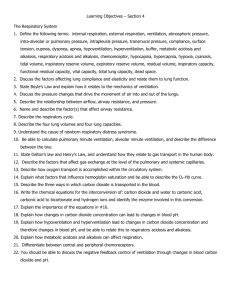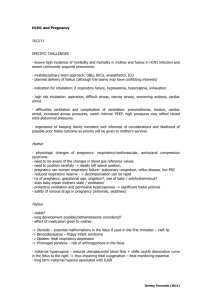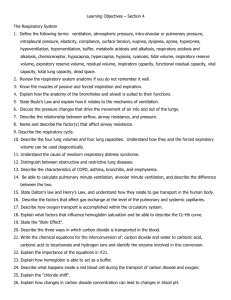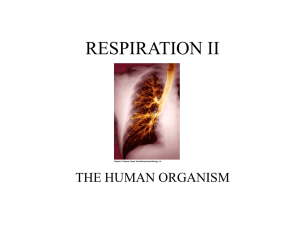NUR 201
advertisement
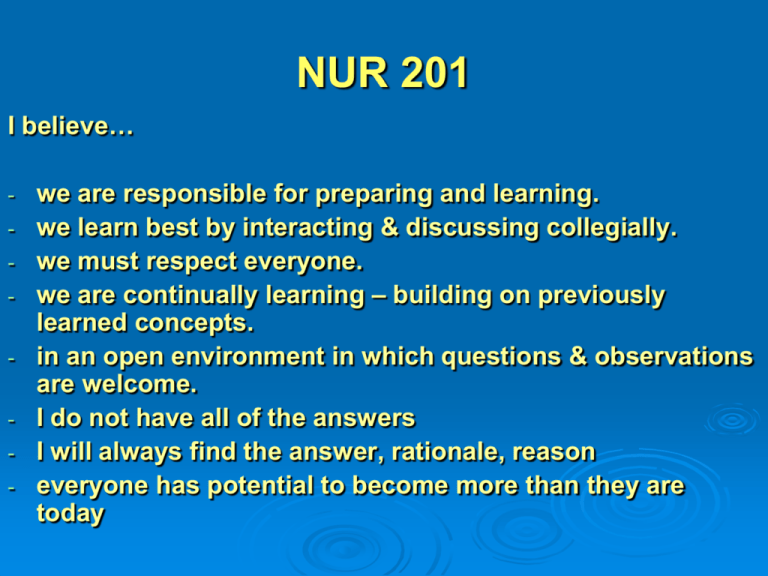
NUR 201 I believe… - we are responsible for preparing and learning. we learn best by interacting & discussing collegially. we must respect everyone. we are continually learning – building on previously learned concepts. in an open environment in which questions & observations are welcome. I do not have all of the answers I will always find the answer, rationale, reason everyone has potential to become more than they are today Interferences with Ventilation Objectives Discuss assessment—breath sounds Describe diagnostic tests for pulmonary function Discuss acid-base balance Examine signs, symptoms, pathophysiology, treatments, and nursing care of respiratory distress syndromes Discuss nursing interventions – mechanical ventilation, tracheostomy, postural drainage Discuss pulmonary accidents—chest trauma, aspiration Content Approach Anatomy & Physiology Review Demographics/occurrence Pathophysiology Clinical Picture Medical Management Nursing Process (APIE) Assessment - Nursing Actions - Education Interferences with Ventilation Respiratory Anatomy & Physiology Anatomy Structure of the Chest Wall: Ribs, pleura, muscles of respiration Upper Respiratory: nose, pharynx, adenoids, tonsils, epiglottis, larynx, and trachea Lower Respiratory: bronchi, bronchioles, alveolar ducts, and alveoli Physiology Ventilation: inspiration and expiration Elastic Recoil: elastin fibers that recoil after expansion Diffusion: Exchange of oxygen and carbon dioxide Arterial Blood Gases / Oximetry Lungs A & P Review Respiratory Assessment A&P Review Thorax Anatomical Landmarks Interferences with Ventilation Alveolar Gas Exchange Interferences with Ventilation Assessment History Cues to Respiratory Problems: Shortness of breath – dyspnea • Orthopnea / Nocturnal dyspnea Wheezing Cough / sputum production Hemoptysis Voice change Fatigue Interferences with Ventilation Assessment Thorax & Lungs Inspection: Posture, chest movement, abnormalities of sternum Respiratory rate, depth, rhythm Palpation: Equality of chest expansion Tactile Fremitus Percussion: Hyperresonance Dullness Auscultation: Discontinuous: fine crackles/rales / coarse crackles / rales Continuous: Wheeze, Rhonchi Pleural friction rub Respiratory Assessment Percussion Larynx Anatomical Landmarks Respiratory Assessment Respiratory Assessment Ascultation Landmarks Respiratory Assessment Breath Sounds Respiratory Assessment Normal Breath Sounds Respiratory Assessment Adventitious Breath Sounds Respiratory Assessment Assessment Definition Clinical Picture Interferences with Ventilation Diagnostic Studies Blood Studies: Hgb, Hct, ABGs Sputum Studies: C&S, Gram Stain, Acid-fast smear; Cytology Radiology: Chest x-ray-- posterior-anterior / lateral Computed tomography (CT) – cross sections of the lung with and without contrast – used often Magnetic resonance imaging (MRI) – images of pulmonary structures – limited use Pulmonary angiogram – x-rays after injection of radiopaque dye– used to dx pulmonary embolism Positron emission tomography (PET) – IV glucose administration – malignant tumors show increased uptake of glucose Ventilation-Perfusion Scan – Perfusion: isotope administration which outlines pulmonary vasculature; Vent: inhalation of radioactive gas which outlines the alveoli – dx pulmonary emboli Interferences with Ventilation Diagnostic Studies Endoscopic Exams (done in x-ray or OR): Bronchoscopy – fiberoptic visualization of bronchi – biopsy; also used to remove mucous plugs, foreign bodies, obstructions Mediastinoscopy – scope through a small incision n the suprasternal notch – visualize mediastinum for tumors, lymph nodes, infections, sarcoidosis Biopsy: Transbronchial or open lung biopsy – done in x-ray or OR Thoracentesis – insertion of a needle into the pleural space – pleural fluid, install medication - done at bedside Pulmonary Function Testing – tests to measure lung volumes and used to dx pulmonary disease, monitor progress, evaluate disability, evaluate response to bronchodilators – done in pulmonary lab Skin Testing – intradermal planning of test dose to assess skin reaction by measuring mm induration – TB, various lung diseases Pulmonary Function Test Relationship of Lung Volumes & Capacities Respiratory Diagnostic Testing Fiberoptic Bronchoscopy Diagnostic Lung Tests Thoracentesis Pair Share – Critical Thinking Upon performing a lung sound assessment of the anterior chest, the nurse hears moderately loud sounds on inspiration that are equal in length with expiration. Where in the airway would this lung sound be considered normal? a. Trachea b. Primary bronchi c. Lung fields d. Larynx Pair Share – Critical Thinking The name that describes the particular lung sound in the previous questions is which of the following? a. Bronchial b. Bronchovesicular c. Vesicular d. Basilar Interferences with Ventilation Regulation of Acid-Base Balance Review Acid – contributes hydrogen ion Two types: • Volatile respiratory acid Dehydrates and excreted in the form of a gas • Nonvolatile metabolic acid Metabolized and excreted in the form of body fluids Interferences with Ventilation Regulation of Acid-Base Balance Review Base – accepts or removes hydrogen ion Buffer- controls the hydrogen ion concentration: • Absorbing hydrogen ions when an acid is added OR • Releasing hydrogen ions when base is added. Three Buffer Systems: Bicarbonate – operates in lungs & kidneys Phosphate – renal tubules Protein – Hgb, plasma proteins, & intracellular protein Interferences with Ventilation Regulation of Acid-Base Balance Factors to remember: Lungs – Eliminate or retain carbon dioxide C02 Kidneys – excrete or form bicarbonate HC03 Food – converted by the body – H20 + CO2 + energy Lung Kidney C02 + H20 = H2CO3 = HCO3- + H+ Interferences with Ventilation Normal Acid-Base Balance Interferences with Ventilation Regulation of Acid-Base Balance Lungs/Respiratory System Increase or decrease hydrogen ion concentration • Through respiratory rate and depth • Result: C02 is either retained or eliminated Changes can occur within minutes Controlled in the medulla oblongata—respiratory center > = increased; < = decreased <pH causes > respirations = <C02 + correcting pH >pH causes < respirations = >C02 + correcting pH Interferences with Ventilation Regulation of Acid-Base Balance Renal System Reabsorb and conserve bicarbonate Can generate additional bicarbonate and eliminate excess hydrogen ions as compensation for acidosis Three mechanisms: • Secretion of small amounts of free hydrogen into the renal tubule • Combination of hydrogen ions with ammonium to form ammonium • Excretion of weak acids • Urine pH 4 – 8 Interferences with Ventilation Regulation of Acid-Base Balance > = increased; < = decreased ABG Condition Respiratory process >PCO2 Respiratory acidosis < PC02 elimination by the lungs -- hypoventilation <PC02 >PC02 elimination by the lungs - hyperventilation Respiratory Alkalosis Respiratory Alkalosis Respiratory Acidosis Acid-Base Imbalance Respiratory Acidosis Hypoventilation from primary lung problem Atelectasis Pneumonia Respiratory failure Airway obstruction Chest wall injury Cystic fibrosis Hypoventilation from other factors Drug overdose Head injury Paralysis of respiratory muscles Obesity Acid-Base Imbalance Respiratory Alkalosis Hyperventilation from primary lung problem Asthma Pneumonia Inappropriate ventilator settings Hyperventilation from other factors Anxiety Disorders of the central nervous system Salicylate overdose Interferences with Ventilation Regulation of Acid-Base Balance Respiratory Function pH PC02 Condition Decreased Increased Respiratory acidosis Increased Respiratory alkalosis Decreased Pair Share – Critical Thinking What acid-base imbalance would you suspect for the patient having respiratory problems with respiratory rate: 28/min and expiratory wheezing? Pair Share – Critical Thinking What acid-base imbalance would you suspect for the post-operative patient with respiratory rate 10/min, difficulty to arouse, but arouses with verbal stimuli Interferences with Ventilation Regulation of Acid-Base Balance > = increased; < = decreased ABG Condition Metabolic process >PCO2 Metabolic acidosis < HCO3- elimination by the kidneys – increased acid <PC02 >HCO3- elimination by the kidneys –increased base Metabolic Alkalosis Metabolic Alkalosis Metabolic Acidosis Acid-Base Imbalance Metabolic Acidosis Starvation Diabetic ketoacidosis Renal failure Lactic acidosis from heavy exercise Use of drugs (ASA, methanol, ethanol) Acute renal tubular necrosis Diarrhea Acid-Base Imbalance Metabolic Alkalosis Excessive vomiting Prolonged nasogastric suctioning Hypokalemia or hypocalcemia Excess aldosterone Use of drugs (steroids, sodium bicarbonate, diuretics) Interferences with Ventilation Regulation of Acid-Base Balance Metabolic Function pH HC03 Condition Decreased Decreased Metabolic acidosis Increased Metabolic alkalosis Increased Interferences with Ventilation Regulation of Acid-Base Balance Normal Values: pH PCO2 7.35 – 7.45 35 – 45 mm Hg HCO3 22 – 26 mEq / L Interferences with Ventilation Regulation of Acid-Base Balance Arterial Blood Gas Intrepretation > = increased; < = decreased Step pH <7.35 = acidosis pH >7.45 = alkalosis Step 1: Evaluate the pH 2: Evaluate Respiratory Function Paco2 >45 mm HG = ventilatory failure & respiratory acidosis Paco2 <35 mm HG = hyperventilation & respiratory alkalosis Interferences with Ventilation Regulation of Acid-Base Balance Arterial Blood Gas Intrepretation > = increased; < = decreased Step 3: Evaluate Metabolic Processes Serum bicarbonate HCO3 <22 mEq/L = metabolic acidosis Serum bicarbonate HCO3 >26 mEq/L = metabolic alkalosis Step 4: Determine the Primary Disorder When Paco2 & HCO3 are both abnormal: • Determine which follows the deviation from the pH and • Deviates the most from normal Interferences with Ventilation Regulation of Acid-Base Balance Arterial Blood Gas Interpretation Respiratory Acidosis: Normal Values pH HCO3Paco2 7.35–7.45 22-26 mEq/L 35-45mm HG Respiratory Acidosis 7.15 25 50 Compensated 7.37 34 66 Interferences with Ventilation Regulation of Acid-Base Balance Arterial Blood Gas Interpretation Respiratory Alkalosis: Normal Values pH 7.35-7.45 HCO3Paco2 22-26 mEq/L 35-45mm HG Respiratory Alkalosis 7.6 24 25 21 25 Compensated 7.54 Respiratory Assessment Relationship between PaO2 & SpO2 Respiratory Assessment Pulse Oximetry Interferences with Ventilation Regulation of Acid-Base Balance Arterial Blood Gas Interpretation Metabolic Acidosis: Normal Values pH HCO3Paco2 7.35 – 7.45 22-26 mEq/L 35-45mm HG Metabolic Acidosis 7.20 Compensated 7.28 15 38 9 23 Interferences with Ventilation Regulation of Acid-Base Balance Arterial Blood Gas Interpretation Metabolic Alkalosis Normal Values pH HCO3Paco2 7.35 – 7.45 22-26 mEq/L 35-45mm HG Metabolic Alkalosis 7.54 36 44 Compensated 7.42 31 50 Pair Share – Critical Thinking Arterial Blood Gas nterpretation Interpret the following ABGs: pH - 7.50 Paco2 – 28; HCO3- - 25; Pao2 - 88 A. Acute exacerbation of asthma. B. Renal failure. C. Acute exacerbation of COPD. Medical Dx: Acute exacerbation of asthma Pair Share – Critical Thinking Arterial Blood Gas Interpretation Interpret the following ABGs: pH -7.28; Paco2 – 52; HCO3- - 26; Pao2 - 68 A. Acute exacerbation of asthma. B. Diabetic ketoacidosis. C. Acute exacerbation of emphysema D. Patient with prolonged NG drainage Pair Share – Critical Thinking Arterial Blood Gas Interpretation Medical Dx: Acute exacerbation of emphysema Pair Share – Critical Thinking Arterial Blood Gas Interpretation Medical Dx: Acute exacerbation of emphysema Pair Share – Critical Thinking Arterial Blood Gas Interpretation Interpret the following ABGs: pH - 7.30; Paco2 – 37; HCO3- - 18 ; Pao2 - 90 A. Acute exacerbation of emphysema. B. Acute episode of asthma. C. Renal failure. Pair Share – Critical Thinking Arterial Blood Gas Interpretation Medical Dx: Renal Failure Pair Share – Critical Thinking Arterial Blood Gas Interpretation Interpret the following ABGs: pH – 7.48; Paco2 – 45; HCO3- - 32; Pao2 – 98 I A. B. C. D. Acute renal failure. Acute diabetic ketoacidosis. Patient with prolonged NG drainage. Patient with prolonged diarrhea. Pair Share – Critical Thinking Arterial Blood Gas Interpretation Medical Dx: postop patient with NG with large amount of NG output Interferences with Ventilation Classification of Resp Failure Hypoxemic PaO2 <= 60 mmHg on 60% O2 Acute Respiratory Distress Syndrome • Direct lung injury: aspiration; severe, disseminated pulmonary infection; near-drowning; toxic gas inhalation; airway contusion • Indirect lung injury: sepsis/septic shock; severe non-thoracic trauma, cardiopulmonary bypass Pathophysiology – • Fluid enters interstitial space and alveoli—impaired gas exchange • < PaO2 and > PaCO2. • Ischemia to pulmonary capillaries • < integrity of the alveolar-capillary membrane Interferences with Ventilation Resp Failure – Medical Tx Goals Maintain adequate oxygenation & ventilation Oxygen therapy Mobilization of secretions • Effective coughing and positioning • Hydration & humidification Chest physical therapy Airway suctioning Positive pressure ventilation Relief of bronchospasm Reduction of airway inflammation Reduction of pulmonary congestion Treatment of pulmonary infections Reduction of severe anxiety, pain, and agitation Treat underlying cause Maintain adequate cardiac output Maintain adequate hemoglobin concentration Interferences with Ventilation Nursing Diagnosis Interferences with Ventilation Nursing Diagnosis Ineffective airway clearance Ineffective breathing pattern Risk for imbalanced fluid volume Anxiety Impaired gas exchange Imbalanced nutrition: less than body requirements Interferences with Ventilation Classification of Resp Failure Hypercapnic PaCO2 > 45 and pH < 7.35 Imbalance between ventilatory supply and ventilatory demand • Supply: maximum ventilation that the pt. can sustain without developing respiratory muscle fatigue • Demand: The amount of ventilatory needed to keep the PaCO2 within normal limits Normally: supply > demand Hypercapnia – ventilatory failure – inability of the respiratory system to ventilate out sufficient CO2 to maintain a normal PaCO2 Interferences with Ventilation Respiratory Failure Causes of hypercapnic respiratory failure Airways & alveoli • Asthma, emphysema, chronic bronchitis, cystic fibrosis Central nervous system • Problems that suppress the drive to breathe – drug overdose, brainstem infarction, severe head injury, spinal cord injuries Chest wall • Flail chest, fractures, kyphoscoliosis, massive obesity Neuromuscular conditions • Guillain-Barre syndrome, muscular dystrophy, multiple sclerosis, myasthenia gravis, ALS Interferences with Ventilation Nursing Management Tracheostomy Care Indications for Tracheostomy Bypass an upper airway obstruction Cases of prolonged intubation & mechanical ventilation Facilitate removal of secretions Permit oral intake & speech in a patient who requires long-term mechanical ventilation Interferences with Ventilation Nursing Management Tracheostomy Care Types of Tracheostomy Tubes Shiley & Portex fenestrated tracheostomy tube with cuff, inner cannula, decannulation plugs & pilot balloon • Fenestrated: openings on the surface of the outer cannula that permit air from the lungs to flow over the vocal cords Allows the patient to breathe spontaneously, speak, & cough up secretions Used by the patient who can swallow without risk of aspiration but requires suctioning for secretion removal. Used by the patient who requires mechanical ventilation for fewer than 24 hours a day Bivona (Fome) tracheostomy tube with foam cuff and obturator Interferences with Ventilation Nursing Management Tracheostomy Care Inserting trach tube Trach tube maintenance Cuff – deflated versus inflated Trach suctioning Removing obturator Sterile procedures Use only Normal sterile saline (NO Water) Apply suction as catheter is withdrawn Cleaning procedure Disposable inner cannula Skin care; Changing trach ties Interferences with Ventilation Nursing Management Patient with a ET Tube or Trach Maintain Breath sounds Maintain proper cuff inflation Cuff pressure 20-25 mm Hg (capillary perfusion 30 mm Hg) Monitor correct tube placement Oxygenation & Ventilation ABGs; pulse oximetry; PETCO2 (partial pressure of end-tidal CO2 Respiratory rate assessment Interferences with Ventilation Nursing Management Patient with a ET Tube or Trach Maintain tube patency Closed and open suctioning Assess patient: • • • • • • • Visible secretions Sudden onset of respiratory distress Suspected aspiration Increase in peak airway pressure Auscultation of adventitious breath sounds Increased respiratory rate / increased cough Sudden or gradual decrease in Pao2 and/or SpO2 Interferences with Ventilation Nursing Management Patient with a ET Tube or Trach Providing Oral Care and Maintaining Skin Integrity Lips, mouth, teeth, tongue, oropharynx q2hr Prevent pressure from ET tube • Ensure ET or Trach is secured properly • Change securing tapes qd & prn Fostering Comfort and Communication Position of comfort Include family in care as appropriate Pain relief Methods of communication: pictures, word chart Interferences with Ventilation Nursing Management Patient with a Trach Nursing Diagnoses: Ineffective airway clearance Impaired verbal communication Risk for infection Imbalanced nutrition Impaired swallowing Ineffective therapeutic regimen management Potential complication—hypoxemia related to misplaced or properly functioning trach tube Tracheostomy Tube Velcro Collar Anatomy of the Tracheostomy Tube Fenestrated Tracheostomy Tube Tracheostomy Suctioning Pair Share – Critical Thinking Humidification of the air is essential for the patient with an artificial airway because humidification helps do which of the following? 1. Prevent tracheal damage 2. Promote thick secretions 3. Dry out the airways 4. Liquefy the secretions Interferences with Ventilation Nursing Management Care of the Patient Requiring Mechanical Ventilation Types of mechanical ventilation Settings Modes of volume ventilation Complications Nutritional therapy Weaning from positive pressure ventilation & extubation Home mechanical ventilation Interferences with Ventilation Nursing Management Care of the Patient Requiring Mechanical Ventilation Types of mechanical ventilation Controlled mandatory ventilation (CMV) – breaths are delivered at a set rate and volume independent of the patient’s respirations Assist-control mechanical ventilation – delivered preset volume & frequency; when pt. initiates a spontaneous breath, a full volume is delivered Synchronized intermittent mandatory ventilation – prevent volume at a frequency synchronized with patient’s respirations – most common form used Interferences with Ventilation Nursing Management Care of the Patient Requiring Mechanical Ventilation Other Ventilatory Maneuvers: Positive end-expiratory pressure (PEEP) -- + pressure applied during expiration – increases functional residual capacity – prevents alveoli collapse Continuous positive airway pressure (CPAP) – prevents patients airway pressure from falling to zero – Used for sleep apnea High-frequency ventilation – delivery of small tidal volume at a rapid respiratory rate – maintains lung volume and reduces intrapulmonary shunting Interferences with Ventilation Nursing Management Complications of Mechanical Vent Pulmonary Barotrauma Volu - pressure trauma Alveolar hypoventilation Alveolar hyperventilation Ventilator-assisted pneumonia Sodium & Water Imbalance – Na+ & fluid retention Neurologic – impaired cerebral blood floor Gastrointestinal – stress ulcer/GI bleed Musculoskeletal – contractures, pressure ulcers, footdrop, complications of immobility Psychosocial = pain, fear, isolation, anxiety, dependency Mechanical Disconnnection or Malfunction – Alarm Alert Interferences with Ventilation Nursing Management Care of the Pt. Requiring Mechanical Ventilation -- Nutrition Establish a nutritional program if the pt is to be without food for 3-5 days Total parenteral nutrition Enteral feedings • Concern: Aspiration Increased carbohydrates = increases CO2 levels Interferences with Ventilation Nursing Management Weaning the Pt. from Mechanical Ventilation & Extubation Weaning: reducing ventilator support & resuming spontaneous ventilation Pre-weaning – assessing Pt respiratory effort • Muscle strength; PEEP; TV; VC; clear lungs Weaning – SIMV – synchronized intermittent mandatory ventilation; CPAP; humidified T-piece Outcome Phase – extubation after hyperoxygenation & suctioning prior to removal; supplemental oxygen, monitoring, need for re-intubation Interferences with Ventilation Nursing Management Home Mechanical Ventilation Negative & positive pressure ventilators Settings and alarms Home Health / Family participation in care Decreased risk for nosocomial infection Concerns: Reimbursement: home health, disposable products may be nonreimbursable Family – respite care Pair Share – Critical Thinking A 72-year old female brought to the ER following a head-on car accident. She has blunt injury to the chest—difficulty breathing, cyanosis; receiving O2 4l/min NC. Assessment priority? Immediate nursing actions

